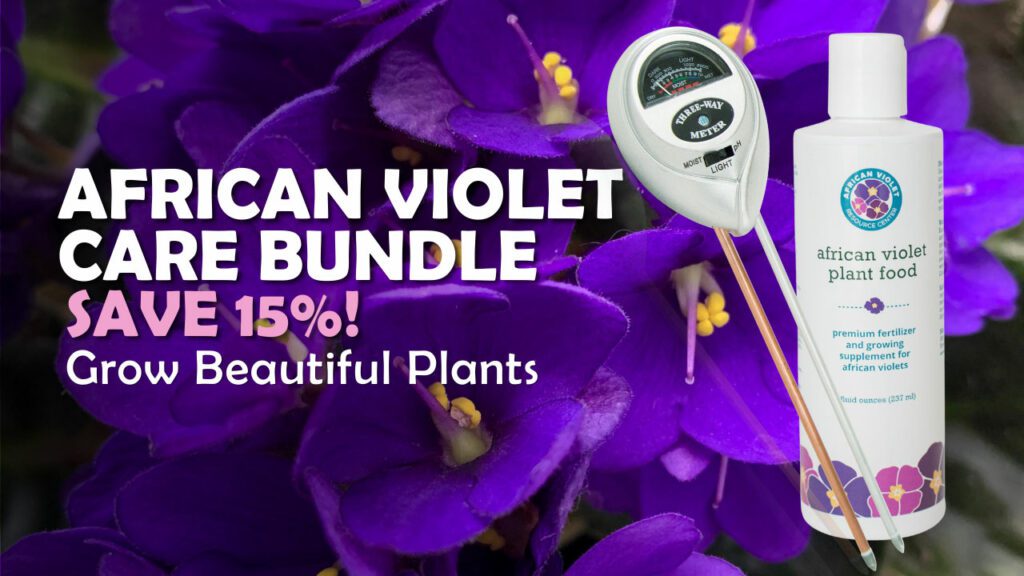If you’re in the market to buy an African violet, here are 5 growing tips to consider before heading to the nursery.
Buying an African violet to add to your indoor garden is sort of a no-brainer. The small, easy-to-grow plants are known for their year-round blooms and unique velvety leaves. They make for the perfect addition to a bookshelf, table, or windowsill and aren’t overly fussy like some other houseplant varieties.
But before you head to the nursery to buy your new African violet keep these growing tips in mind.
Tip #1: African Violets Like Indirect Light
In the wild, African violets grow beneath thick forest canopies. They’re protected from harsh sun rays by other wild foliage like treetops, brush, and lush forest plants. For this reason, African violets do best in bright indirect light and suffer if they’re not protected from direct sun rays.
Too much direct sun will easily burn your African violet. If your African violet is getting too much sun, it’ll show signs of burning. The telltale warning signs are brown spots or damaged leaf tips.
On the other hand, too little light will prevent your African violet from growing hearty leaves and blooming consistently. If your plant looks leggy or has elongated leaves, it’s likely searching for more light, so feel free to move it to a brighter room.
To prevent uneven growth and ensure your plant keeps its symmetrical rosette form, be sure to rotate your African violet every week or so.
Professional Tip: If you’re ready to buy an African violet, make sure you have a bright room to place it in, but don’t forget that your plant should not be in the line of direct light.
Tip #2: African Violets Don’t Do Well When Over-watered
Like other tropical, warm-climate plants, African violets don’t do well when they’re over-watered. As a general rule, avoid keeping your plant in soggy potting mix. Only water it when you’re sure the mix has thoroughly dried.
Over-watering can easily lead to root rot, a condition that damages your plant’s roots and prevents it from absorbing nutrients from its growing mix. Without healthy roots, your African violet won’t live long. But with a healthy root system that’s free of rot, your African violet will live for many, many years.
Professional Tip: If you’re worried about watering your African violet, you can opt for a self-watering pot. These are perfect pots for African violets since they’re designed to keep plants optimally hydrated and they remove the risk of spilling water on your plant’s leaves.
Tip #3: African Violets Thrive in Warm, Humid Environments
Lucky for us, African violets prefer the same temperatures most people find comfortable. If you keep your home somewhere between 70 and 80 degrees Fahrenheit during the day and between 65 and 70 degrees Fahrenheit at night, your African violet will feel right at home.
If you keep your home cool and dry, consider using a humidity tray to create a moist environment around your African violet. This will help keep your plant happy since it’ll bask in the moist air as the water in the humidity tray evaporates.
Professional Tip: Be sure to place your African violet away from floor vents or fans to avoid cold drafts or bursts of cold air which can damage your plant.
Tip #4: African Violets Need the Right Pot and Growing Mix
Potting your African violet in whatever soil you have on hand is a grave mistake. Traditional potting soils are dense and retain water. These are two features that will damage your African violet’s roots and likely prevent your plant from blooming.
The best potting mix for your African violet will be light and porous, which will allow your plant’s roots to dry quickly between waterings. For best results, use a potting mix made for African violets in particular. If you’d like to make your own, you can use a mixture of peat moss, perlite, and a small amount of garden soil.
In general, African violets don’t enjoy big soil-filled planters, and they bloom best when they’re slightly pot-bound. Choose a small pot for your plant to encourage bloom.
Professional Tip: Before heading to the store, be prepared to buy a pot for your African violet so you can repot it when you return home. Click here for some tips on choosing the perfect pot for your plant to thrive in.
Tip #5: African Violets Need the Right Fertilizer
In the wild, plants are able to grow in nutrient-dense environments. When we keep our plants pot-bound indoors, their growing mix can become depleted of nutrients quite quickly. So, it’s your job to provide your African violet with adequate nutrients so it’ll thrive indoors.
The right fertilizer will act as a multivitamin for your plant and encourage big, bold blooms and lush, velvety leaves. The trick is to use a carefully formulated fertilizer. Traditional plant feed can be acidic and harm your plant’s delicate root system.
Professional Tip: Use a gentle, liquid fertilizer every time you water. Our African Violet Plant Food is made with humic-fulvic acid and sea kelp extract to boost nutrient uptake and encourage hearty roots and vibrant blooms. It’s gentle enough to use every time you water and won’t burn your plant like most traditional plant food.
Stock Up on These Accessories Before You Buy African Violets
Here’s a list of must-have accessories to purchase before you buy African violets. With these items on hand, you’ll set yourself up for growing success.
Follow the links below to buy the plant accessories we use ourselves to maintain lush African violets year-round.
- Buy a well-draining potting mix to keep your plant’s roots healthy.
- Keep your AV on a humidity tray to keep your plant adequately hydrated and avoid dry leaf tips.
- Use a self-watering pot to avoid over-watering your plant.
- Buy African Violet Plant Food to keep your African violet nourished and blooming year-round.
For continued success, explore our other articles, visit our online shop, and connect with other African violet plant lovers in our Facebook group. There, you’ll find everything you need to know to grow your African violet big and strong so you can enjoy it for years to come.







